Feature
Anatomy of an IPPY Award Winner
A Conversation with the Creators of Five Oceans and a Teaspoon
IP got the chance to speak with Warren Lehrer and Dennis Bernstein about their new book of visualized poetry, Five Oceans in a Teaspoon, which combines written poetry, visual art, animations, music, and live readings into a stunning
“performative experience." Five Oceans in a Teaspoon won the 2020 Independent Publisher Book Award gold medal for Poetry.
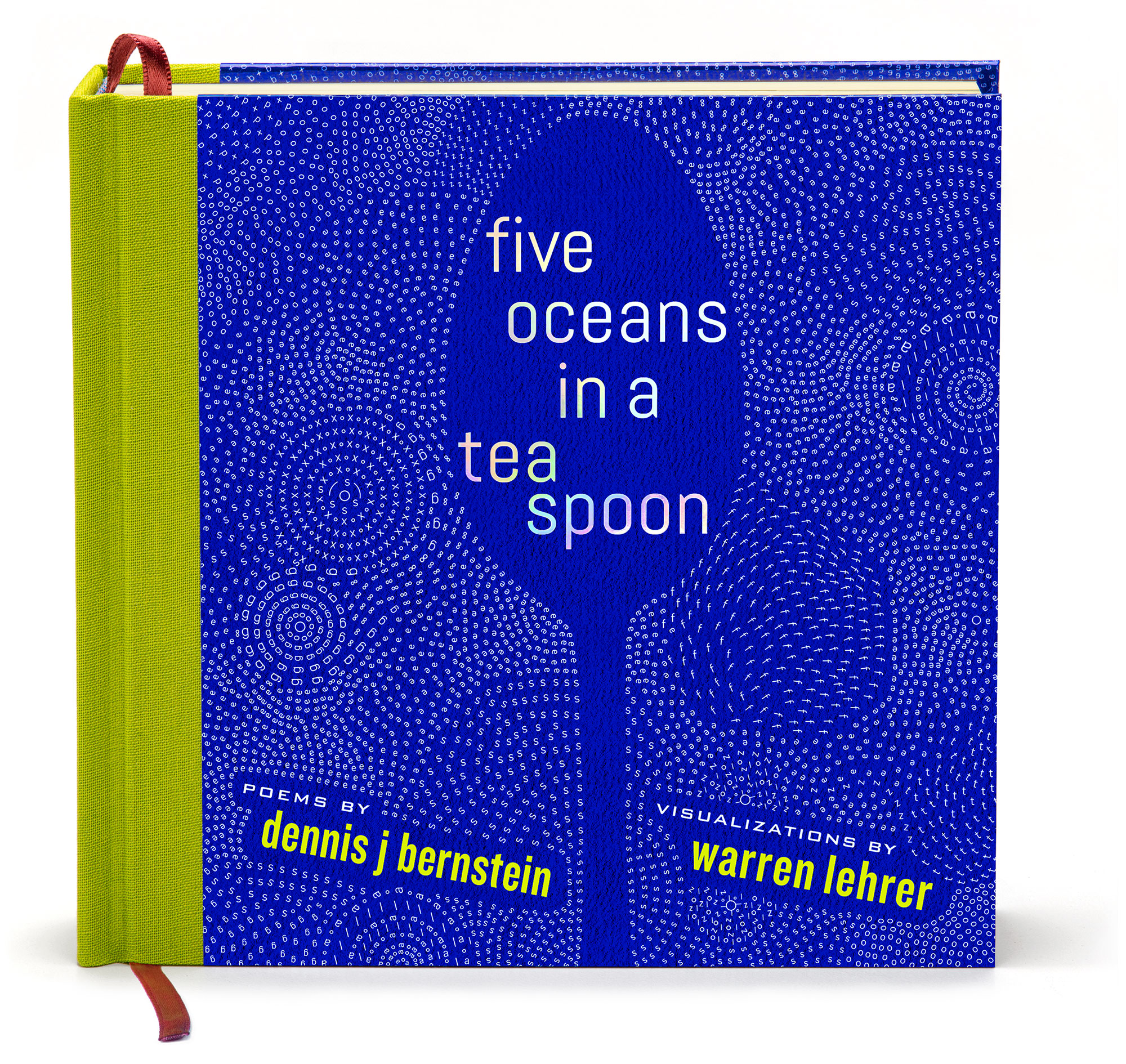
This project marks a 40-year friendship and partnership between poet Bernstein and visual artist Lehrer, who have also collaborated on plays, books, and poetry collections. Lehrer is not new to the IPPY Awards -- his “illuminated novel” A Life in Books: The Rise and Fall of Bleu Mobley was an IPPY Outstanding Book of the Year for Most Original Concept in 2014. In our interview, Lehrer and Bernstein give insights on their past collaborations and how their unique artistic backgrounds have shaped Five Oceans in a Teaspoon.
IP: Five Oceans in a Teaspoon can be read as a book of poetry, but it encompasses much more than just the printed page. Why did you decide to incorporate animation, performance, and live readings into the project? Can this blend of written work and live performance be found in any of your other collaborations?
Lehrer: Dennis and I are both students of the spoken word, the way people talk and what they have to say. It makes sense for that orality, which finds translation on the page, to want to come full circle into presentations that are spoken and sung both in live events and through other media. For me, books are not just convenient vehicles for containing and transporting texts, although they’re often used that way. Books have the potential of being a time-based art medium with unique properties and countless possibilities much like film, theater and music. The Five Oceans in a Teaspoon book itself, I believe, is a performative experience for the reader. They activate the score when they read it. But you’re right, the book sits at the center of a multibranched project. This is an approach I have taken with many projects for decades, including Dennis’ and my 1984 book/play French Fries, which manifested in performances that incorporated acting, music and dance.
As much I love the Five Oceans book, the typographic animations allow for a different kind or interpretation/performance of Dennis’ poems. With animation you have the element of time and also sound. The original soundtracks for all the Five Oceans videos are masterfully scored and performed by Andrew Griffin. In the animation of the poem Living with Alzheimer’s, letters struggle to become words, search for memory; thoughts halt, rotate and stretch in a confusion of pleasure, frustration, habit and empathy. In Knitting Club, a circle of women spin yarns that unfold into patterns of storytelling, textiles, music at once down to earth and of the spheres. In Avowel, while the page composition diagrams the domination of a minority over a majority (vowels over consonants), the animation allows for a more visceral expression of injustice. The lines connecting the consonants to the vowels hang and swing more like ropes, reader/viewers can see and feel the resistance, hear the haunting soundtrack, and perhaps conjure associations with the gruesome history of slavery in America, the Jim Crow south, and the living legacy of systemic racism. The animations can be seen online as an augmented extension of the book. We also project them and poems from the book in our live performance/readings, and in exhibitions.
In our NYC book launch events, which included other readers and actors, we also had live musicians who accompanied some of our recitations and performed select poems that were scored into songs by Dominic Frigo and performed by viola, piano, and two sopranos. For instance, the poem "Lullaby," which reads “i’m the baby of the family / i change my mommy’s diapers and rock her to sleep in my arms” was composed by Frigo into a heart wrenching canonic lullaby for multiple voices.
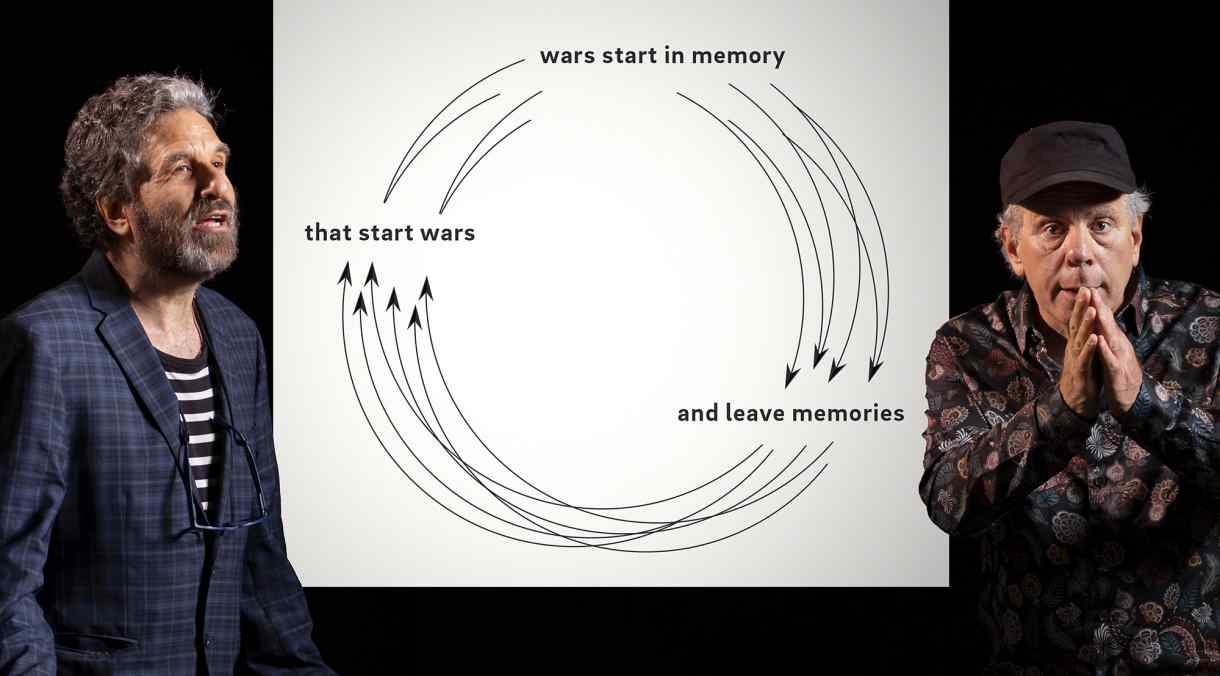
The exhibitions allow for other kinds of manifestations including ink jet prints of poems that are more than twice the size of the book pages and video projections of the animations. In an exhibit at the Center for Book Arts in NYC, some of the poems were enlarged and adhered to gallery walls, ceilings and doors. The poem “Police Brutality (On Steroids)" which reads— "it took an entire squad of cops to put him under cardiac arrest"—wrapped around the corner of two adjacent walls at a downward slope so reading the poem echoed a chase around a neighborhood and its deadly outcome.
IP: You started working together 40 years ago. How did you first meet? What was your first collaborative project?
Bernstein: Warren answered an ad for a place to live in Queens, while he was attending Queens College. Maybe if he knew that I had almost burned the house down a couple of weeks prior, he might not have wanted to move in. Or maybe when he heard the details of the story—that I had fallen asleep with pen in hand, while searching the thesaurus for the right word—he would have been more encouraged to move in. But move in he did, and we’ve been working together on and off creating multimedia projects ever since. I still have that thesaurus, with the burnt corner from the poetically inspired conflagration, when the search for the perfect word almost cost me my life.
Soon after Warren moved into that house, we were sharing our creative output with each other. He dug my writing and almost immediately began scavenging through my notebooks for the good stuff. And I began to see his evolution as an artist and his commitment to working words into pictures. I was moved by the constant struggle he had with teachers telling him that you can be a painter or a poet but you can’t be both. That was incredibly moving to me, and somewhere that is the door we both came through together, with words and images. Where I started to understand that language could take on another dimension through the use of typography and visual form.
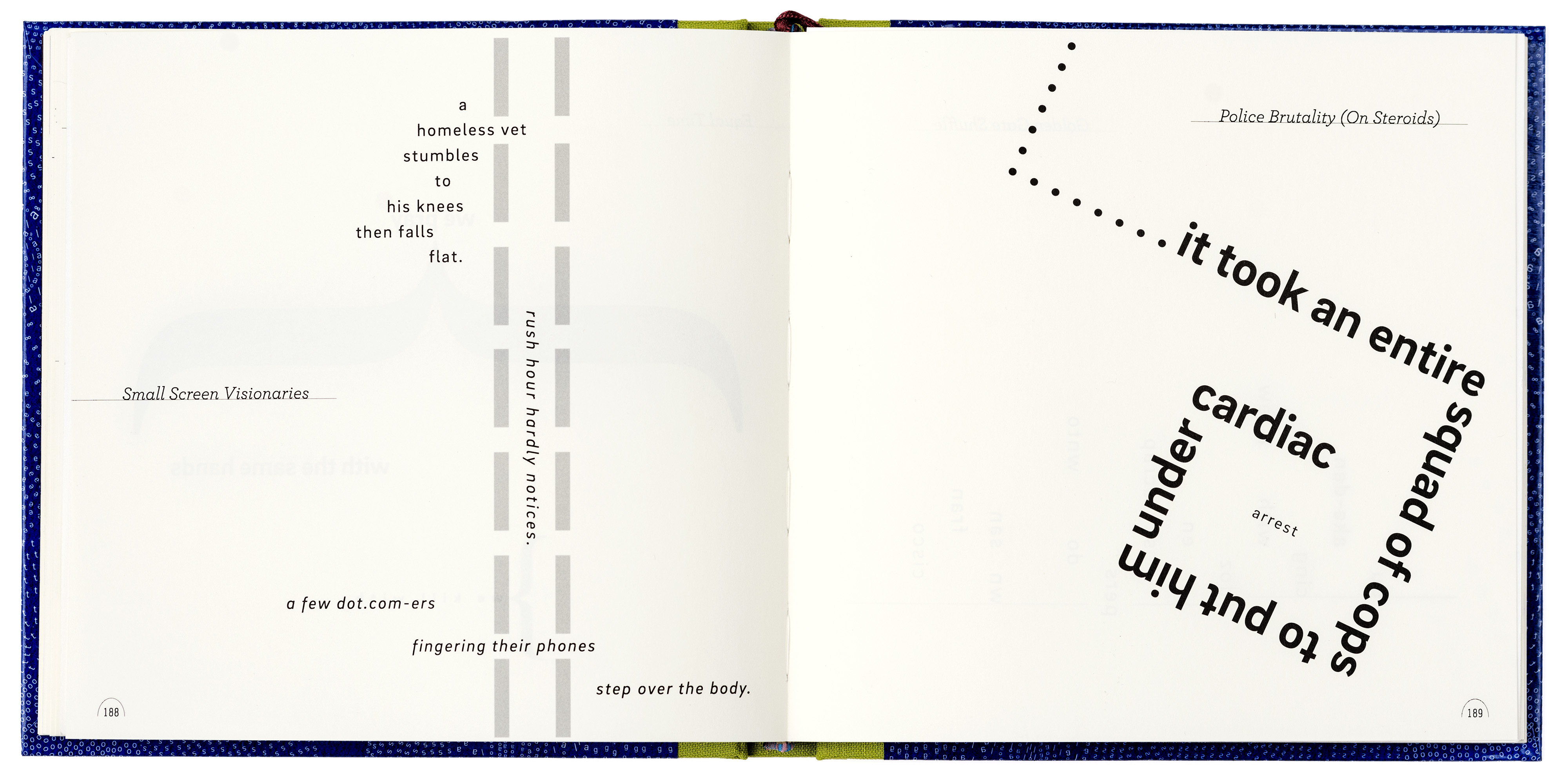
A few years later, in 1979, we began working on a book of my short poems that Warren was reinterpreting through typographic compositions. The working title was Stretch Marks. It was seven inches square and was going to consist of different thematic chapters, or movements as Warren calls them. We put together a little mock-up of sample pages from the book and William Packard the publisher and editor of NY Quarterly wrote a wonderful introduction. But somehow we never finished the book. Instead we went on to write our first play together. My sense looking back on it, is neither one of us was quite ready to finish that book of poems. It took 40 years to get back to that project which ended up being Five Oceans in Teaspoon.
The play we wrote in 1980, titled Social Security: The basic Training of Eugene Solomon, incorporated some poems from the aborted poetry collaboration but it also grew out of the playful sound jams and out loud improvisations Warren and I used to do together. That play would be very timely at this pandemic moment in history. It included chanting, songs and a soundtrack created by composer Robert Kaplan. Social Security was the evolution of a young man, based on all the pro-war, macho imagery he was subjected to growing up, from football and boxing to the endless combat stories repeated by his father, and the simmering fear, almost from birth, of cold-war nuclear annihilation. He emerges into manhood as a full-fledged survivalist who opens his own survivalist shop selling all the gadgets and herbs you need to survive a pandemic or nuclear war or personal late-night mugging.
IP: How is Five Oceans in a Teaspoon different from the other projects you’ve worked on together? How is it similar?
Bernstein: All the projects are similar in that they are dramatically different from each other, but thoroughly original in their approach to an oral tradition translated to the visual page. And all of our best work together represents a synergy of word and image and searching for meaning out of the madness and joys of life and living in the USA.
Our second and more fully realized play was also a book which Warren designed that has become a canonic work in the world of artists’ books and Visual Literature. It takes place on one day at the fictional fast food joint Dream Queen, when one of the customers is found dead in a pool of blood and ketchup. We called it a quick-service circus of culinary discourse, dream, memory, loss and twisted aspiration.
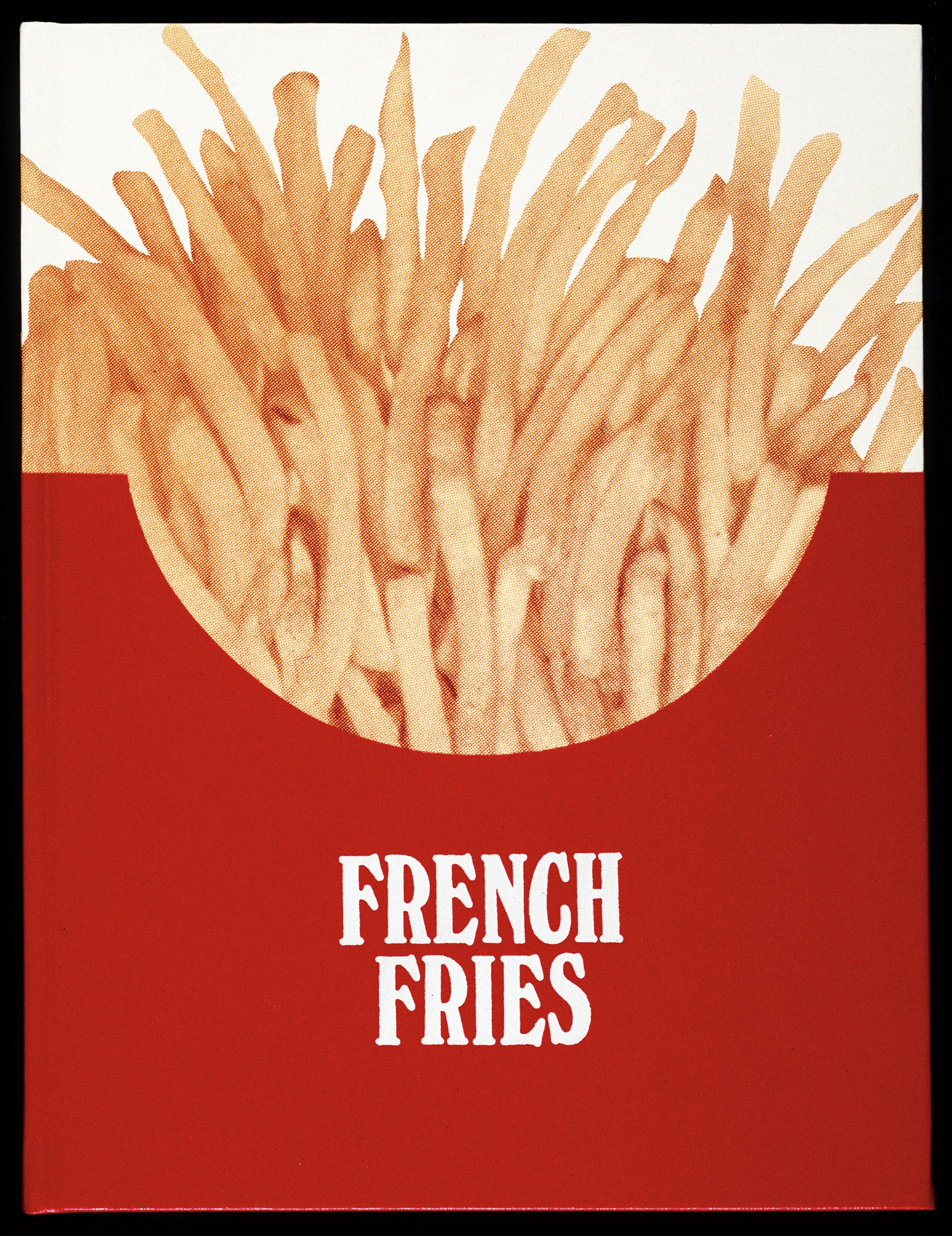
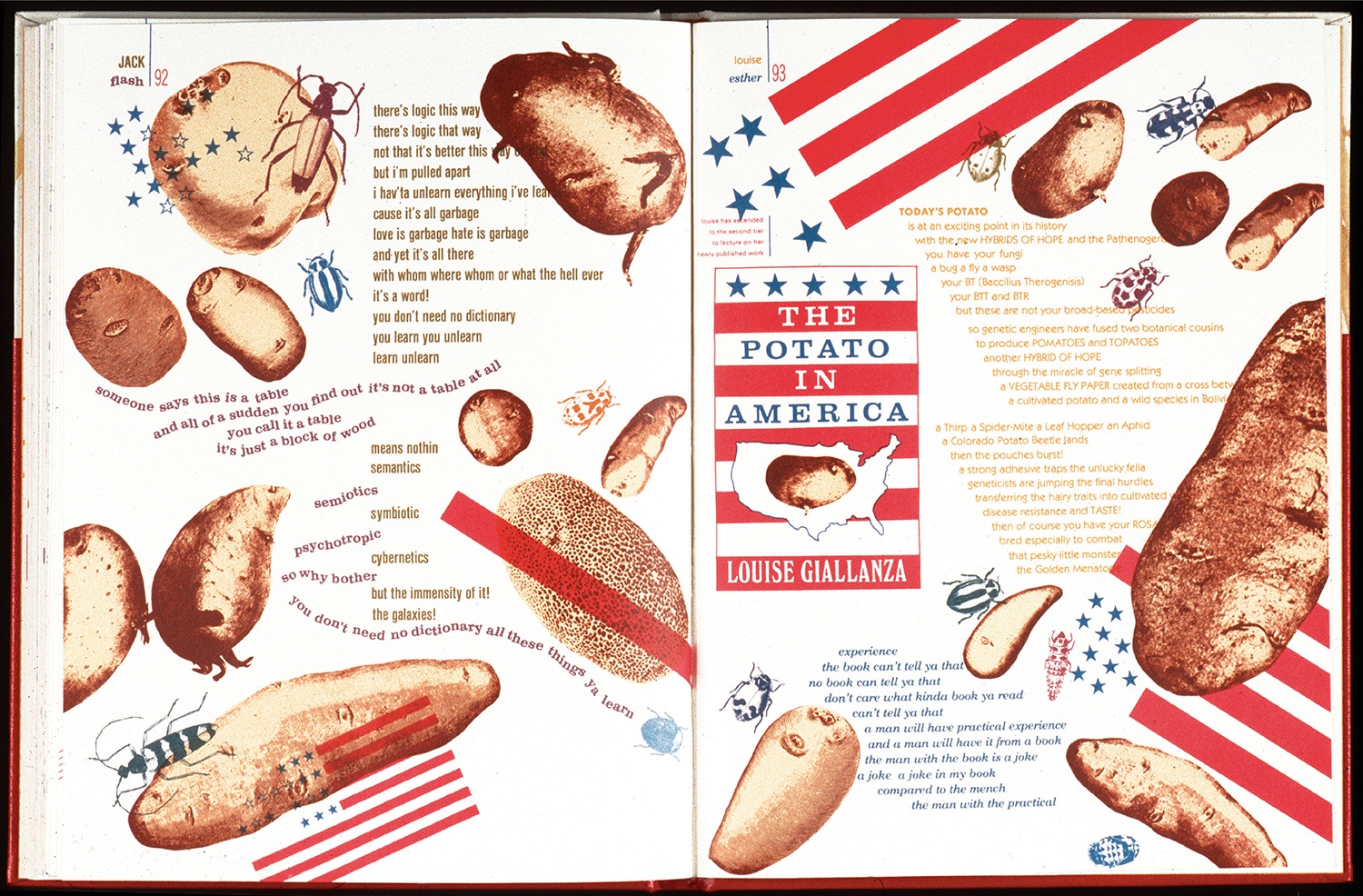
Then in 1987 Warren asked me to write chants and stories for a book he was working on based on weavings of imaginary animals by the amazing textile artist Sandra Brownlee, which ended up being a 464 page animal fantasy fugue. Warren wrote an introduction to the book but he was having trouble writing a text for this otherwise very visual and fanciful book of sequenced images about the “lost and forgotten animals of the earth.” In GRRRHHHH: A Study of Social Patterns, Warren’s visual narratives based on Sandra’s weavings gave me the chance to overthrow the English language that had haunted me early on in my public school years. In the chants and stories I wrote for GRRRHHHH, I created my own language complete with a glossary of literary terms. I was deeply inspired at the time by the ancient mystics and by James Joyce’s Ulysses, which I had produced for the radio—the first 35 hour complete live reading, broadcast over Pacifica and NPR, from “Bloomsday Books.” Producing that broadcast transformed me. I brought some of that energy to GRRRHHHH. There were no limitations of traditional language in my quest to animate the creation scenes and evolutionary journeys of the five imaginary animals.
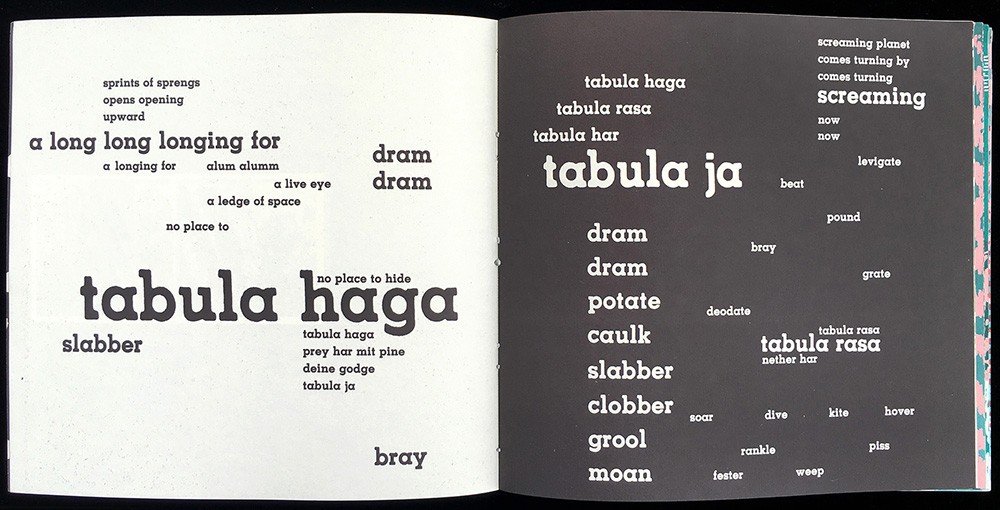
Warren also helped edit and format my poetry collection Special Ed: Voices from a Hidden Classroom published in 2012 by New York Quarterly Books, based on my years teaching “special ed” kids in Far Rockaway in the 1970s. Warren also designed the cover. But his participation in that book was more traditional, neutral. That was very much my book.
Whereas, Five Oceans in a Teaspoon, is really our book. A full collaboration. My poems, Warren’s visualizations. It includes some of the poems that were in that original effort 40 years ago. That was a starting point, but it really includes a lifetime of my poetry, the shorter poems, and turned into a highly personal autobiography in poems, culled, transformed and interpreted by Warren’s visionary touch. In Five Oceans, I literally got to throw the book at Warren, my book of daily poetry for which he never seemed to tire. And the poems came back to me as part of a new world order, my words celebrated through these typographic compositions, showered with respect for their multiple meanings and unrelenting joy, madness, rage, and quiet observations.
IP: How is your visual poetry different from more traditional forms of written poetry? Do you think it is more impactful or accessible than traditional forms?
Lehrer: I appreciate the question. First, I’d like to reframe it a bit, since I think visual poetry has a long and rich tradition itself, and the comparison is not so binary. Unlike writers of prose, poets have always cared about the “shape” of their writing. Whether it’s metered or free verse, no poet is going to let a publisher, printer, designer, or software program fit their writing into an arbitrary column width. When it comes to the visual composition of a poem, almost all poets have been mindful of line breaks as an indicator of pacing, rhythm, breath and sense pauses. Stanzas structure the reading flow as well. To that extent, even what we think of as “traditional poetry” acknowledges the relationship between visual and literary form. Quite a few poets take this to the next step, playing with capitalization, punctuation, and arrangement of the words on the page. And then there are those writers (of prose and poetry) who simply can’t detach the literal, poetic and visual form of their writing.
The traditions of visual poetry date back to at least 1700 BC with the “Phaistos Disk,” a clay disk carved with hieroglyphic Minoan symbols that spiral clockwise toward its center. Ancient examples of Pattern Poetry can be found all over the world, most prominently during the early Christian era. Many of these poems were written/scribed (mostly in Latin) in multiple directions, running top to bottom, side to side and diagonally, in multiple colors, and very often contain supplementary text hidden within the body of the poem, intended to be discovered/gamed out by the reader. The visual poetry we equate with the Modern era—of Mallarmé and Apollinaire, the Dada and Futurist poets, e.e. cummings, Gertrude Stein, to Concrete Poetry, Plastic Poetry, Letterism, Poesia Tecnologica, and electronic/computational poetry—are extensions of those ancient forms of poetry and illuminated writing that have never disappeared. While Visual Literature has been sidelined/discounted in the past century by most gatekeepers (mainstream publishers, editors, critics, professors) in the literary world, it is more alive than ever thanks to the technological changes in writing machines and the means of distribution, challenges to traditional and arbitrary conventions, and the experimental fervor of independent practitioners, collaborators and publishers.
All that said, I think every poet has an infinite number of choices to make and variables to work from when they write a poem. As a writer myself, I can’t help but “see” the words on the page (or screen) as an integral part of the writing composition. My goals in that regard are to find the shape of thought and speech via typography (sometimes incorporating images and icons). While many writers consider typography a “neutral” or “transparent” conduit for the written word, my approach is more expressionistic. Type can be used to distinguish and evoke different voices, help give visual form to feelings, ideas and metaphors, and add to the layered meanings within a text. I also like the idea of animating the reader with works that engage their participation. You can read and see more about my work at warrenlehrer.com.
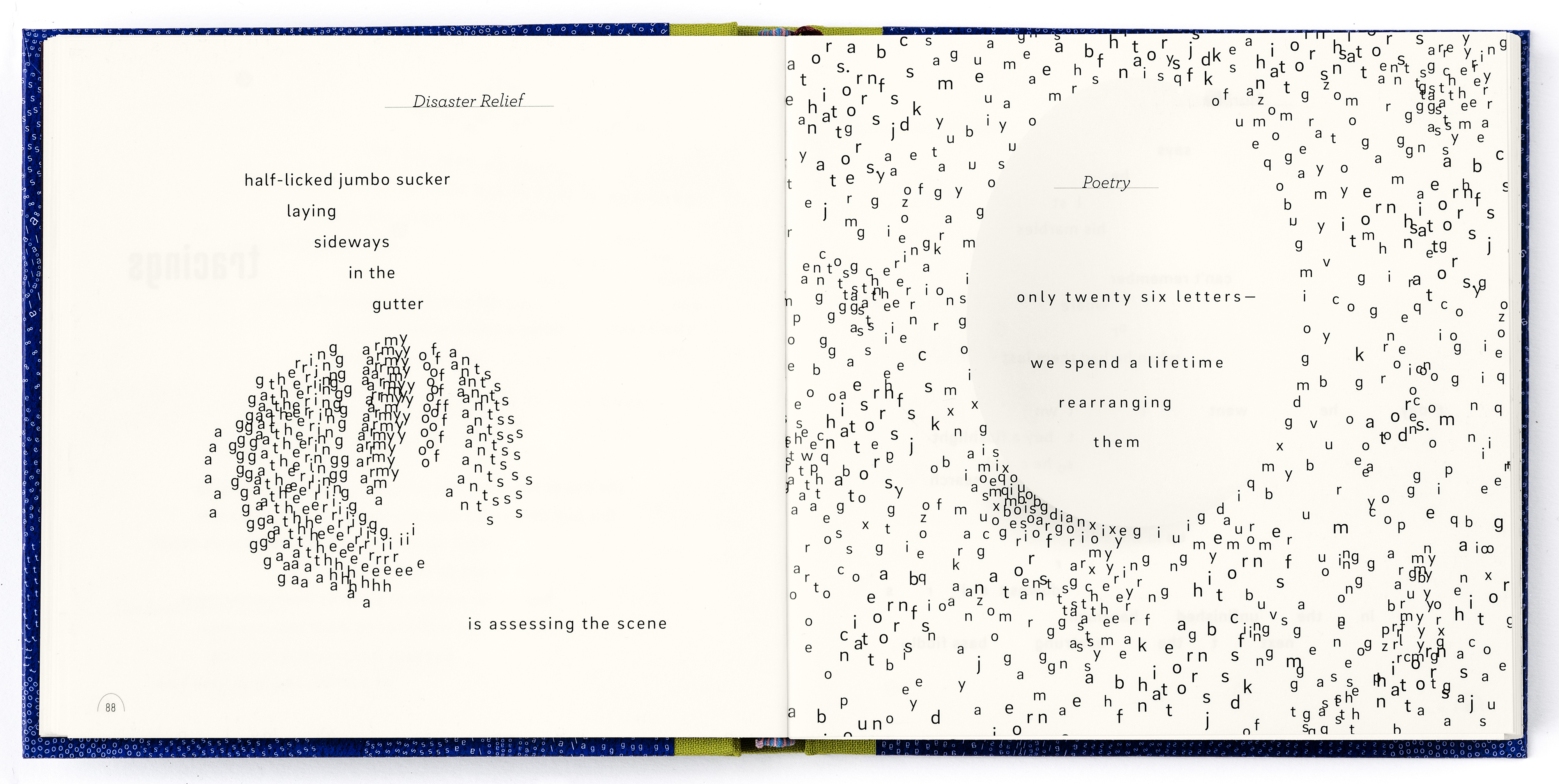
As a reader, I approach every poem or piece of writing on its own terms. If the writer isn’t utilizing the visual aspects of a text, I don’t discount it. Visually composed or not, it comes down to whether I’m moved or not, whether I care about the subject matter and approach, and whether the writing is excellent or not. I have long been an admirer of Dennis J Bernstein’s writing, particularly his poetry. The poems in Five Oceans in a Teaspoon are exquisitely crafted. There’s an immediacy to the voices in the poems and a vulnerability to the characters who reveal a wide array of humanity. Informed by a well observed and hard-won life, the poems are often funny and possess a gutsy, raw energy and brutal truth to them. This is the first of my eleven books that I didn’t write or co-write. But I adore Dennis’ poems and was compelled to collaborate with him on this book, especially after he gave me the gift of entrusting his words with me. The poems in this collection never needed the help of my visuals. But they do come to life in a different way in these settings, and I think the collaboration took us beyond what either of us could have done by ourselves.
IP: Dennis, how does your work as a journalist influence your creative work? Does your work as an investigative journalist influence the themes and topics that you approach in your poetry?
Bernstein: I recognize that frontline journalism is crucial for giving people the information they need to make decisions about their lives. I especially love uncovering stories that are otherwise overlooked. I believe I do that on Flashpoints, the daily syndicated investigative news program I produce and host, and in my print and online journalism. But reporting and journalism can also be shallow. To really get to somebody, you have to start with the heart, which is also where a poem starts for me. Oftentimes people are turned off by hard politics. But if you take a poem by my poetry teacher, Muriel Rukeyser, called “Islands,” the first line is “Oh, for God’s sake, they are connected underneath.” Good poetry gets at the heart and inspires a different way of thinking, in this case of how to bring people together. I love the idea of poetry taking off where information doesn’t go.
With journalism there’s a laser-like interest in getting the story right, but poetry isn’t stark like that. There’s more room for ambiguity and contradictions. Poetry can also allow you to be a gentle witness to things that are otherwise not talked about. Witnessing two flies copulating on a wall, a fisherman on the Pacific Ocean, swarms of insects around an abandoned piece of candy, trying to add up the numbers on your aunt’s concentration camp tattoo, the larger patterns of life. From the smallest things to the largest, poetry can deal with all kinds of content. Whereas hard information starts in the brain, good poetry starts in the heart and works its way out through the blood system, becoming a part of the body and informing the brain.
Of course, being a human rights reporter has a major influence on my poetry, as I witness first-hand the multiple struggles that black and brown and native peoples face as racism still remains pervasive in the culture. Indeed, there is the poetry of struggle that rises in the voices of those who must speak truth to power just to stay alive. The heroic stories of these confrontations open the emotional and inspirational door to poetry.
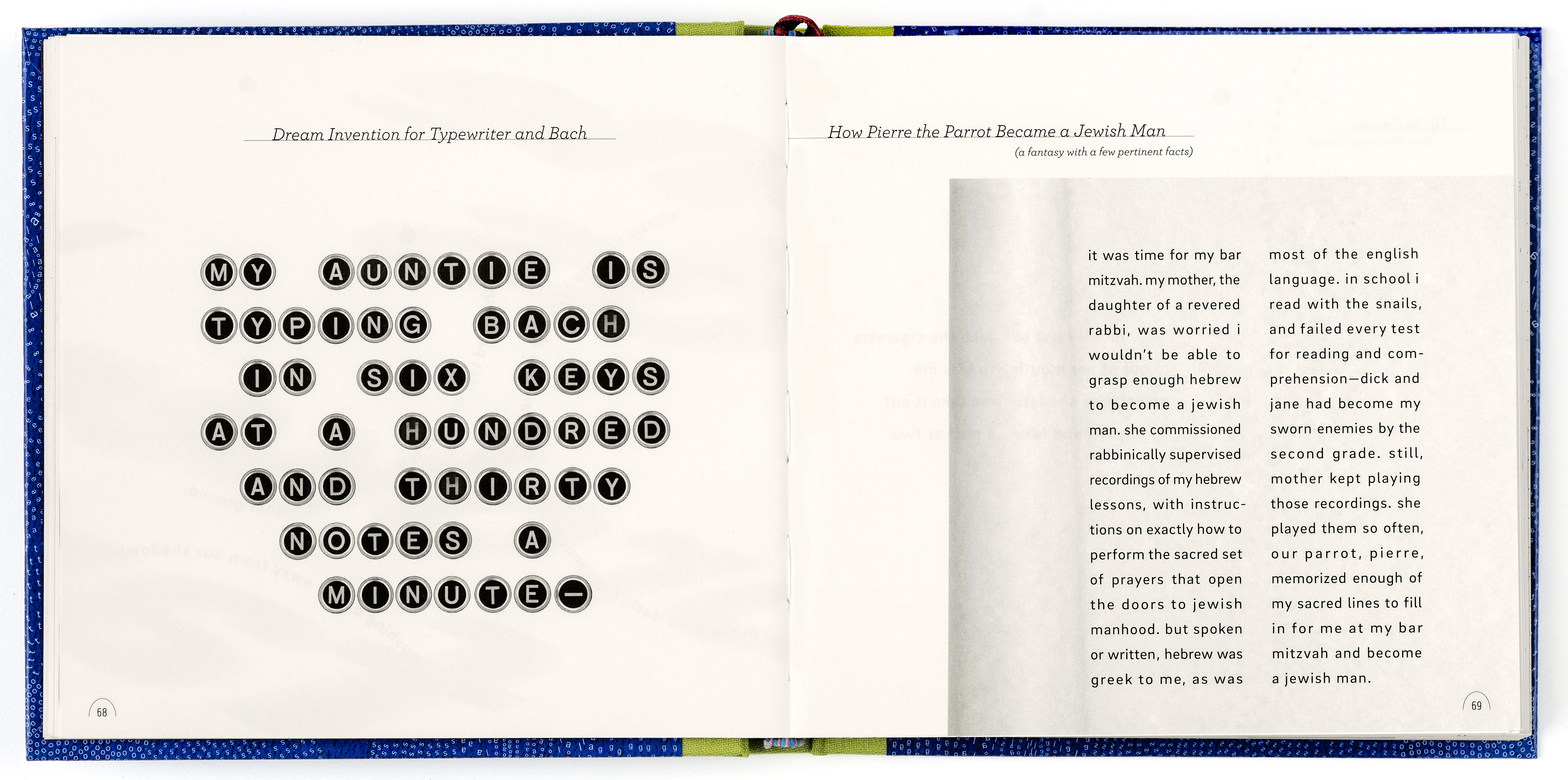
My close friend, the late Earth Firster, Judi Bari was blown up, car bombed in the streets of Oakland, while in the planning stages of Redwood Summer Actions to save what was remaining of the ancient forests of Northern California. Bari sued the FBI and the Oakland Police for failing to investigate the bombing, and then trying to blame her for bombing herself. Bari wrote the deposition for the lawsuit on her death bed—a masterpiece that won the day in court, a fifty thousand word poem. And when Judi sued the FBI, the suit also included her missing fiddle. One of the last song-poems she penned was “The FBI Stole My Fiddle.” I think her power as a troubadour equaled and balanced her power as a political organizer.
My political poetry habit was inherited from my mom who was also an avid lover and writer of poetry, as were all of her six sisters. For my mom, poetry was an artform but it was also an effective weapon in pushing back against the violently sexist man’s world she did battle with in the workplace of the 1950’s and 60’s. My mom used to refer to her make-up as war paint, as she sipped her morning java and prepared for daily workplace combat. When I was lucky, Mom would let me roll on her rouge and apply her lipstick. Poetry was her grace and her secret weapon; she’d just post her biting verse over the water-cooler and prepare for combat. Mom also taught me the power of silence between the words.
ONE WOMAN STRUGGLING TO BREATHE
She’s talking to herself in a language from another planet.
I learned the nouns and verbs of it during the long hours
and days when she didn’t say anything at all. She just
cooked the meals and ironed our shirts. Not even a single
syllable, just the sound of one woman struggling to breathe.
As I write this, the streets in cities all over America are smoking with anger. People of color, and their supporters, have had enough of on-camera police violence and murders. Five Oceans in a Teaspoon has a special poetic and artistic relevance to this movement against police killing and systemic injustices. Several poems in Five Oceans are directly ignited by two of these on-camera killings, in which the police choke their suspect to death, even after he has been thoroughly subdued. These poems of struggle are brought into a new light by Warren’s typographic interpretations which sometimes shadow the original, sometimes speak to the meaning of the poem with a sixth sense, and sometimes just cut right through you like a bullet at close range.
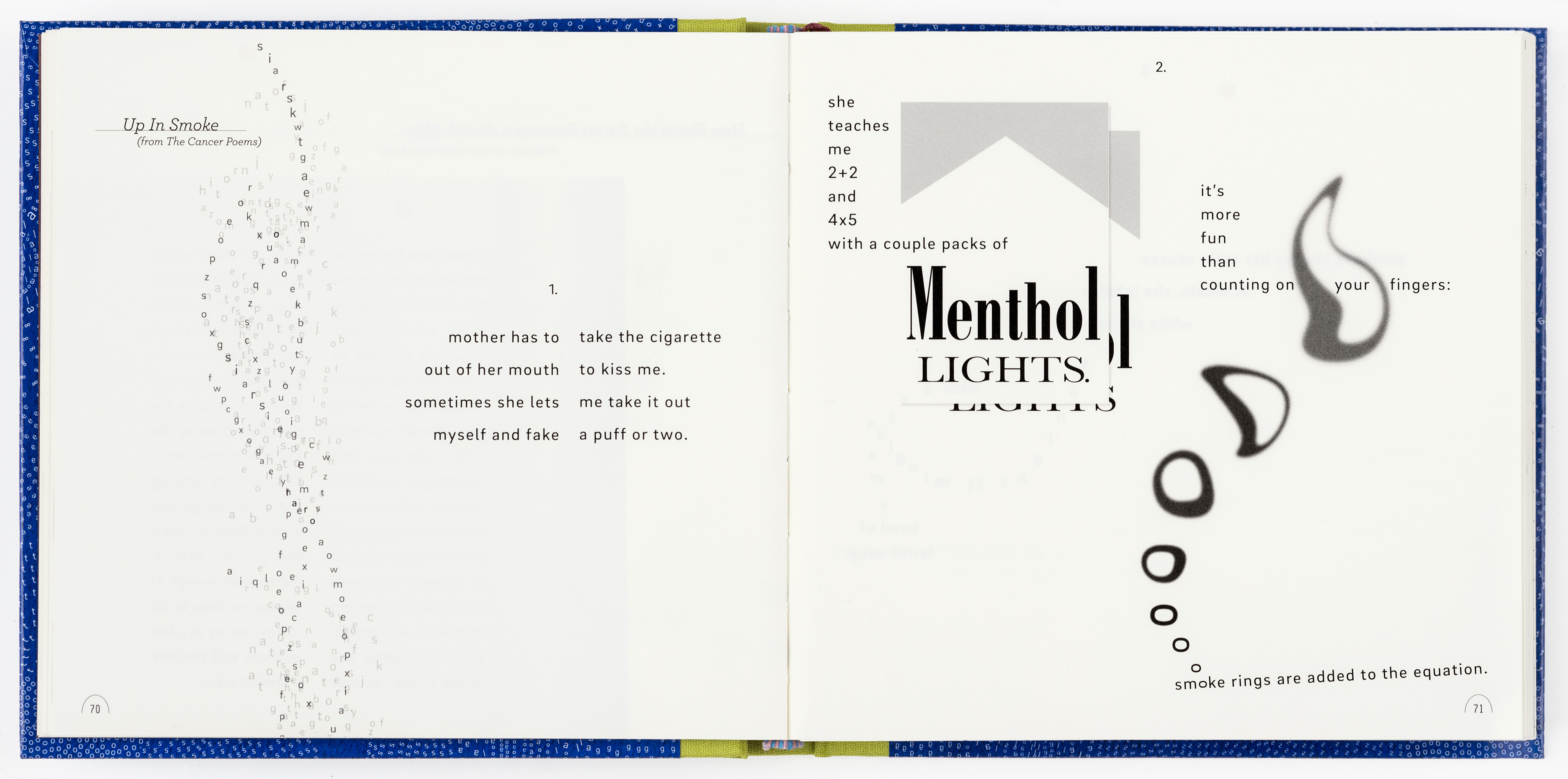
IP: Warren, what is your approach to visualizing Dennis’ poetry? How do you choose the images, shapes, and layouts to best emphasize the message behind a poem?
Lehrer: The reboot of this project that we started in 1979 happened unexpectedly in the spring of 2015. I was staying at Dennis’ apartment in San Francisco while touring the Bay Area with my last book, the illuminated novel A Life In Books: The Rise and Fall of Bleu Mobley. Dennis started showing me these new short poems he was writing in notebooks that were smaller than the ones he usually carried around. He said the bigger notebooks were too intimidating. “All that blank space.” The shorter page size yielded shorter poems. I noticed a poem in one of the notebooks called “ten smiles” that included a little doodle of ten smiles. For some reason I took out my laptop and began transcribing the poem and the doodle typographically making the smiles out of parenthetical brackets. Dennis really liked it. One thing led to another and I ended up looking through several thousand of Dennis’ short poems that he wrote over the past 45 years.
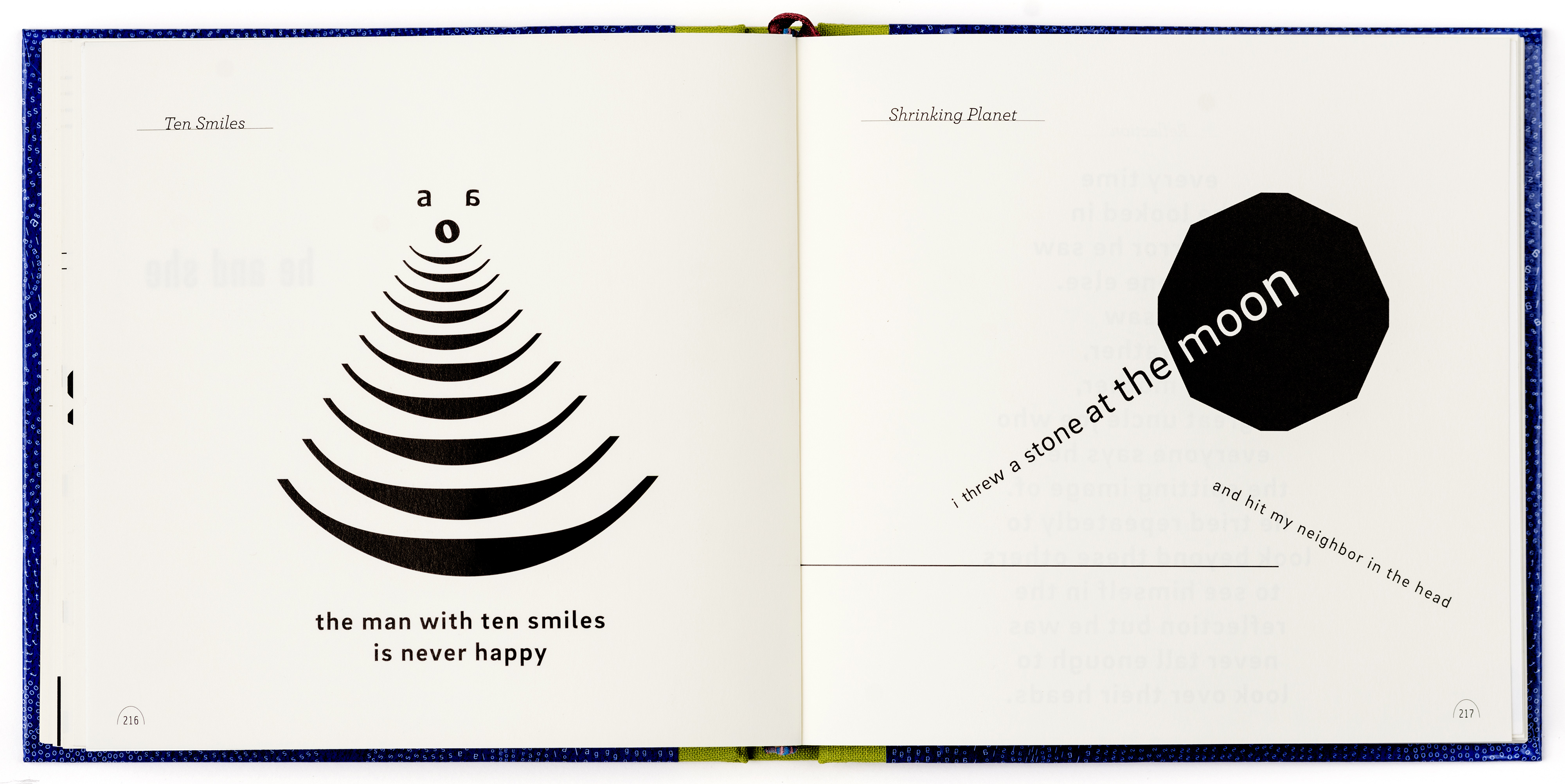
My first job was to select the poems that really spoke to me. Most of them did not have visual cues. They’re typewritten just as text, several lines to a poem, though many of them function on several levels. Visualizing each poem was a mysterious process. I always let the writing take the lead, and I follow it. Appropriate to the brevity of the poems, I used minimal means. My palette was almost entirely typographic, employing one main type family (Brix) throughout the book. (Other typefaces make cameo appearances as additional voices and characters.) The ideas within each poem, its themes, metaphors, double meanings, ambiguities, subtexts, conflicts, voices, characters, structure, rhythmic cadences, underlying intent and emotional underpinnings were all grist for the mill. I work in a page layout program, and I go till I find the form for the poem. It could take 100 pages trying and trying, taking the last iteration of what I’ve done, copying it and pasting it in another page and tweaking it some more, trying this and that until a visual composition is realized. I know I’m done when the form feels revelatory and has a grace, as if it couldn’t be any other way. Some compositions allude to figuration or landscape, while most work more abstractly, diagramming the interior, emotional and/or metaphorical underpinnings of the poem. The best compositions, I think, engage the reader to become active participants in the discovery, navigation, puzzle, and experience of the poem.

For instance, the visual composition of the very first poem in the book, “Dyslexia,” attempts to get beyond the stereotype of dyslexia as just being about reading words backwards. In addition to taking cues from the poem itself, I talked with Dennis about his own experience of dyslexia. So you have letters that are on the move, rotating up, flopped, moving diagonally and bouncing around. My hope is that the reader not only reads the text of the poem, but also has an experience of dyslexia.
After I visualized around 300 of Dennis’ poems, I structured the book into eight movements, that form a sort of narrative starting out with childhood, becoming a frontline witness to war and its aftermaths, to prison, street life, love and loss, concluding with growing older, having open heart surgery, caring for aging parents and visitations from them after they’re gone. The structure is informed by the arc of a life but it also has a musical structure. Most poems (we ended up with 225) fit on one page, so the way two poems speak to each other on a two-page spread is important. Some poems take up a full spread, and there are suites of poems that flow over a series of spreads. Each movement has ebb and flow, build ups and denouements, themes and variations, segues and contrasts. Many of Dennis’ poems are voice poems, and whether you hear the voices in your head or read them out loud, my hope is that the aggregate experience is symphonic; speaks to your heart as well as your head. And the book itself is appreciated as an object, feels at home in your hands, from the quarter cloth binding with foil stamp and embossing, to the uncoated archival paper, and the seven inch square pages that taken as a whole distills a wide expanse of territory with minimal means.
Bernstein: One last thing, if I may. One of the wonderful things about working with a Visual Literature visionary like Warren, is once I find that perfect word, the synergistic sentence, and the dropdead linguistic image, Warren takes it to the next level, or maybe to the next three levels, turning a strong image on the written page into a moving newsreel that animates the poet’s unconscious: In my case, that includes the exalted visual translations of a profoundly dyslexic writer, utilizing typographic visions and sound, which then become the transliterations of the twisted mind of a dyslexic poet, who has had near deadly run-ins with every letter in the alphabet.
One of the special insights I have on the book, and its part of the genius that Warren brings to our work together, is his ability to see the beauty in the life-long struggle I’ve had with the written word and how Warren translated that struggle to the living page and later in the animations. I have joked with Warren that sometimes I need to consult my Dyslexic Guide to Reading Five Oceans—my original manuscript of the poems—to read the poem, because it’s like having double dyslexia, trying to read Warren’s profound interpretation of what the dyslexic poet sees. Here is the original poem:
Dyslexia
I answer to many names but
the alphabet confuses me.
Every day I drown
in 26 sounds: And
i’ve never been
able to stay
between
the lines.
Compare this to Warren's version for Five Oceans in a Teaspoon. Instead of papering over my struggle, pinning the words, letters and phrases down to the page so they can be immediately understood, Warren honors the struggle of the dyslexic and makes the reader get into the shoes of the dyslexic poet in order to read the poem.
* * * * *
Written by Dennis Bernstein. Visualized by Warren Lehrer.
Introduction by Steven Heller.
Published by Paper Crown Press, September, 2019.
ISBN 978-9969506-3-3
6”x6”x 302 pages. Hardcover, quarter cloth binding. Archival paper.
Full color cover with embossed type, metallic foil. Black and white interior.
Purchase book here: http://www.papercrown.press/fiveoceans
* * * * *
Cece Richardson is a contributing writer for Independent Publisher. She studies English and Theatre at Benedictine College, where she spends her time acting, writing, and producing radio shows. You can find her on twitter @CeceRichardson6.

